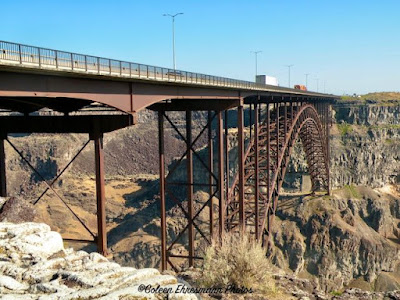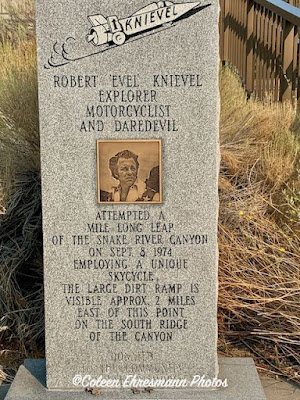We have begun our journey back to South Dakota. We spent a couple of nights in Twin Falls ID. This is what we saw, or at least what I think is the highlights.
Our first destination was Centennial Park, along the Snake River. The town of Twin Falls is on the canyon ridge behind us as we snaked our way down to the park. There was a golf course at the park and options for launching canoes, kayaks, water boards, and maybe boats although I did not see any boats.
This green and fertile valley was the ranch of Ira Perrine, founder of Twin Falls.
Perrine was a farmer and rancher and responsible for getting a dam built on the Snake River to help bring water to the land on the ridge. His family lived on Blue Lakes Ranch until 1964 when the land became the Blue Lakes Country Club, the golf course you see in the first photo.
One of the water falls along the canyon wall driving the road to Centennial Park.
The Perrine Bridge is Highway 93 crossing the mile wide Snake River. The bridge has walking paths on the two sides. We stopped at the Visitors Center for the next photos.
The Perrine Bridge is approximately 1,500 feet (457 m) in total length, with a main span of 993 feet (303 m) and a deck height of 486 feet (148 m) above the Snake River it is the eighth highest bridge in the United States. The elevation above sea level for the bridge deck is approximately 3,600 feet (1,100 m). ~ Wikipedia
Someone on a Paddle Board on the Snake River.
And some kayakers. There were several.
This area has a history of volcanic activity. Lava rocks are used all over the city-rock walls, landscaping, trails and foot paths.
The Perrine Bridge is a popular BASE jumping site known all over the world; it may be the only man-made structure in the United States where BASE jumping is allowed year-round without a permit. Jumpers often use the nearby visitor center as a home base before and after parachuting from the bridge. ~ Wikipedia
Hubby talked to one guy rolling and packing his parachute. He had jumped twice that day and was planning to do a third. We saw vehicles in the Visitor's Center parking lot with BASE jumper stickers. One van was equipped as a camper with food stuffs to rival the travel trailer pantry. So these are serious enthusiasts who travel great distances to jump off a bridge!
We stopped at the area twice, and each time 3-5 guys (mostly) were rolling and packing chutes. As we left the last time, a woman (younger) had slipped into the harness and one the 'professional' BASE jumpers was taking her to the east side of the bridge for her jump. I say 'professional' as I got the impression one could hire them to use their knowledge and equipment IF one so desired to jump off a bridge nearly 500 feet above the water. We did not stick around for her jump, but she was on the deck as we drove toward the campground.
The Shoshone Falls are several miles northeast of the Perrine Bridge and Twin Falls. It is the location of the first of several power plants.
Sometimes called the "Niagara of the West," Shoshone Falls is 212 feet (65 m) in height, 45 feet (14 m) higher than Niagara Falls, and flows over a rim nearly one thousand feet (300 m) in width. ~Wikipedia
Water flows westward over Twin Falls and is controlled by the Twin Falls Dam, built in the 1930s and used for irrigation and hydroelectric power generation. There were originally two parallel falls, but the dam permanently diverted the flow from the southern falls, leaving a single (north) waterfall.
And speaking of irrigation and agriculture, this poster at the Visitors Center says it all. I also learned Idaho is the third largest state producer of dairy (milk). At one time milk from Idaho was trucked to the Lake Norden cheese plant.
Another claim to fame for Twin Falls is the Mile Long Leap of the Snake River by Evel Knievel in 1974.
This is the ramp Knievel used to launch his flight. (a dirt hill with some remaining concrete on the upside) A 180 foot structure was atop the dirt hill.
He invested nearly $1 million dollars in the stunt. He leased 300 acres for the fans, television crews, and support staff. The cost was $35,000 for the fee and legal permits.
This is looking across to the north rim, 1 mile away. The jump was unsuccessful. The ramp and the X-2 Skycycle were designed and built by Bob Truax, but rather than a high powered motorcycle, he created a rocket.
Here is a youtube video link to his jump: Evel Knievel & the Snake River
On September 16, 2016, stuntman Eddie Braun did what Evel did not: he successfully jumped the Canyon in a rocket motorcycle built by the son of the man who built the original rocket motorcycle. It was named "Evel Spirit" in Knievel's honor.


















The falls are gorgeous in Twin Falls so now on our list. Can only imagine what that first step off the bridge to would feel like, eeeks! Watched the footage of the jump from Evil... Do you think it was a publicity stunt? Thanks for all the interesting facts in the blog!
ReplyDelete